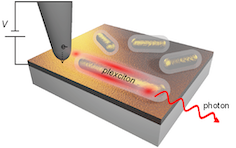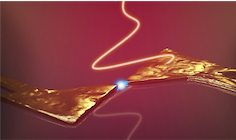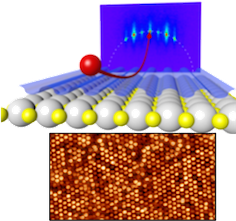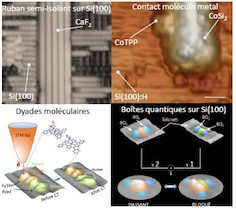Home > Research Teams > Nanophysics@Surfaces (Nanophys) > Research
Research
Scanning Probe Nano-optics
The study of nano-optics involves the ability to confine and manipulate light at the nanoscale, despite the well-known “diffraction limit”. The specificity of our group is that we use inelastic tunneling electrons to locally and electrically excite surface plasmon polaritons or excitons in nano-objects and theoretically include quantum effects in the modeling of such systems. The tunneling junction giving rise to the excitation is most often the one found between the tip of a scanning tunneling microscope (STM) tip and the sample, but may also be the integrated nano-junction of a device. In particular we focus on plasmonic and excitonic systems, but we also contribute experimentally and theoretically to the development of STM-induced luminescence spectroscopy of individual molecules (in an STM at low temperature under ultra-high vacuum). |
Ultrafast Dynamics
Pour cela, nous utilisons des méthodes théoriques de dynamique quantique et des méthodes expérimentales de spectroscopie non-linéaire de type pompe-sonde. |
Ultrathin films & Nanostructuring
Nous combinons des techniques instrumentales de diffraction d’atomes et d’électrons, microscopie à sondes locales et spectroscopies optiques. |
Molecular Nanodevices
Les processus de transfert de charge, de transport électronique ou d’interaction quantiques sont principalement abordés dans cet axe. |






